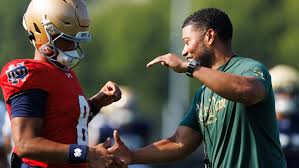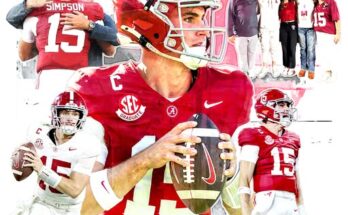“Built on Trust: How the Notre Dame Fighting Irish Are Turning Unbreakable Bonds into a Modern College Football Powerhouse”
In just 20 days, the echoes will once again awaken inside Notre Dame Stadium, and Irish fans will turn their eyes toward a new season, a new opportunity, and another chapter in the long and proud history of Fighting Irish football. But as that countdown ticks closer to kickoff, it is only fitting to honor some of the legends who made Notre Dame what it is today. Among those iconic figures, there stands one defensive back whose name resonates through time, whose play redefined the cornerback position at Notre Dame, and whose presence helped shape two national championship runs in the 1970s. That man is none other than Luther Bradley, the gold-helmeted warrior who wore No. 20 with pride, intensity, and a relentless passion for shutting down some of the best offensive players in college football history. Bradley was not just another defensive back; he was the epitome of what Notre Dame football stood for—toughness, excellence, and the will to dominate the opponent in every phase of the game.
When you think of Notre Dame’s tradition, images of Rockne, the Four Horsemen, Parseghian, Montana, Theismann, and countless others flash through the mind. Yet for every great offensive figure, there are defensive stalwarts who carried equal importance in securing championships, and Bradley represents the defensive backbone of the era in which he played. His tenure at Notre Dame coincided with one of the golden periods of the program, where Ara Parseghian and later Dan Devine molded the Irish into perennial contenders. Bradley’s impact was felt immediately upon stepping onto the field. From his first snaps, there was no question that this young man from Florence, South Carolina, had the instincts, physicality, and confidence to lock down receivers and change the course of games.
Known for his ability to blanket receivers, Bradley quickly earned a reputation as a true “shutdown corner.” The term is thrown around often in today’s football world, but Bradley embodied it at a time when passing games were becoming more sophisticated and opponents were trying to exploit defensive secondaries with speed and precision. Yet, when teams lined up against Notre Dame, they had to account for Bradley’s side of the field. Receivers who ventured into his territory often regretted it, either being blanketed into irrelevance or punished with bone-rattling hits that made them think twice about coming back. He wasn’t just content with deflecting passes—he thrived on taking the ball away.
His knack for interceptions placed him in rarified air in Notre Dame history. Bradley holds the school record with 17 career interceptions, a mark that has stood the test of time and remains a testament to his vision, anticipation, and ability to close on the football. Those interceptions were not merely statistics; they were momentum-shifting plays, the kind of moments that could turn the tide of big games and put Notre Dame back in control. Every great team has a defensive anchor, and for the Irish of the mid-70s, Bradley was exactly that.
But what truly separated Bradley from many other corners of his era was his physicality. While some cornerbacks prefer to stick to coverage duties, Bradley tackled like a linebacker, unafraid to step up and meet running backs head-on in the open field. His ability to deliver punishing hits and strip the ball from carriers added another dimension to his already impressive game. He was not simply a cover corner; he was a complete defensive back, capable of locking down the pass and enforcing against the run. Opposing offenses had no safe option—throwing his way was risky, and running to his side could be dangerous as well.
The 1973 season serves as one of the finest examples of his impact. That year, Ara Parseghian’s squad went undefeated, culminating in a classic Sugar Bowl victory over Alabama to secure the national championship. Bradley, as a young star, played a vital role in a defense that stifled some of the nation’s best offenses. The Irish secondary, anchored by his presence, was able to limit explosive plays and force teams into mistakes. Notre Dame’s tradition of defensive excellence was reinforced that season, and Bradley’s contributions were front and center.
Fast forward to 1977, and Bradley again stood at the heart of another championship run. By then, he had matured into a seasoned veteran, a two-time First Team All-American who was recognized across the country as one of the premier defensive players in all of college football. That 1977 team, led by coach Dan Devine, had one of the most memorable campaigns in Notre Dame history, highlighted by the “Green Jersey Game” against USC, where the Irish rolled over the Trojans in an emotional and dominating performance. Throughout that season, Bradley’s steady leadership and defensive prowess ensured that the Irish remained a force to be reckoned with. When they capped the year with a Cotton Bowl victory over Texas to claim another national title, Bradley’s fingerprints were once again all over the achievement.
Two national championships, two-time consensus First Team All-American, and the school’s all-time leader in interceptions—Luther Bradley’s resume speaks volumes. Yet beyond the numbers and accolades, it was the aura he carried on the field that defined him. Fans who watched him play recall a defender who exuded confidence, who thrived in one-on-one battles, and who elevated the play of everyone around him. His presence in the secondary gave linebackers and safeties the freedom to be aggressive, knowing Bradley would handle his responsibilities with excellence.
His career at Notre Dame also paved the way for a successful future in professional football. After his dominant collegiate career, Bradley was drafted in the first round of the 1978 NFL Draft by the Detroit Lions. While his NFL career may not have reached the same iconic heights as his time at Notre Dame, he still left an indelible mark by carrying forward the Irish tradition of producing top-tier defensive talent. Bradley also spent time in the USFL, further showcasing his longevity and passion for the game. But no matter where he played professionally, his reputation was already cemented—Luther Bradley was, and always will be, a Notre Dame legend.
The legacy of players like Bradley is not measured solely in statistics or championships. It is measured in the way future generations of Irish defenders look back at his tape, study his approach, and model their own play after his physical, aggressive, and intelligent style of football. For every cornerback who has lined up in Notre Dame’s blue and gold since, there has been a standard to uphold, and Bradley’s shadow looms large as part of that standard.
Even today, decades after he last donned the gold helmet, his name still commands respect among Irish faithful. To wear No. 20 at Notre Dame is to wear the memory of Luther Bradley, the shutdown corner who dominated receivers, the ball hawk who took the ball away more than anyone else in school history, and the defensive warrior who helped deliver two national championships to South Bend.
As we sit just 20 days away from Notre Dame’s next battle under the lights of the “House that Rockne Built,” it is worth reflecting on how the program has been built by legends like Bradley. Every Saturday, when the Irish take the field, they carry with them the spirit of the past—the players who laid the foundation, who gave their all for the gold helmet, and who left behind legacies that inspire new generations of Irish fans. Bradley is not just part of Notre Dame’s history; he is woven into its fabric, a symbol of defensive excellence and championship toughness.
The countdown to kickoff is not only about looking ahead to what the current team will accomplish, but also about remembering and celebrating the warriors of the past who made it possible. Luther Bradley was one of the finest to ever represent Notre Dame, and his name deserves to be spoken alongside the greatest to ever wear the uniform. The shutdown corner, the ball hawk, the enforcer, and the champion—he was all of these and more. And as the echoes prepare to awaken once again, fans can look back with pride at No. 20 and know that Notre Dame football will forever carry his legacy forward.
In 20 days, the Irish will march out to battle again, and while the players on the field will be different, the tradition remains the same. It is a tradition built by men like Luther Bradley, who showed the world what it means to be a Notre Dame man—fearless, relentless, and unyielding in the pursuit of greatness. That is why, when Irish fans recall the legends who wore the gold helmet, the name Luther Bradley will always command respect, admiration, and gratitude.



